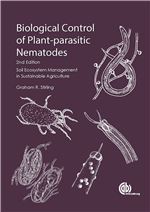Description
Biological Control of Plant-parasitic Nematodes (2nd Ed.)
Soil Ecosystem Management in Sustainable Agriculture
Author: STIRLING Graham R.
Language: English
Subjects for Biological Control of Plant-parasitic Nematodes:
Approximative price 173.00 €
In Print (Delivery period: 14 days).
Add to cart536 p. · Hardback
Description
/li>Contents
/li>
Plant-parasitic nematodes are one of multiple causes of soil-related sub-optimal crop performance. This book integrates soil health and sustainable agriculture with nematode ecology and suppressive services provided by the soil food web to provide holistic solutions. Biological control is an important component of all nematode management programmes, and with a particular focus on integrated soil biology management, this book describes tools available to farmers to enhance the activity of natural enemies, and utilize soil biological processes to reduce losses from nematodes.
Section I: Setting the Scene
1. Ecosystem services and the concept of ‘integrated soil biology management’
Section II: The Soil Environment, Soil Ecology, Soil Health and Sustainable Agriculture
2. The soil environment and the soil-root interface
3. The soil food web and the soil nematode community
4. Global food security, soil health and sustainable agriculture
Section III: Natural Enemies of Nematodes
5. Nematophagous fungi and oomycetes
6. Nematodes, mites and Collembola as predators of nematodes, and the role of generalist predators
7. Obligate parasites of nematodes: viruses, and bacteria in the genus Pasteuria
Section IV: Plant-Microbial Symbiont-Nematode Interactions
8. Arbuscular mycorrhizal fungi, endophytic fungi, bacterial endophytes and plant-growth-promoting rhizobacteriaSection V: Natural Suppression and Inundative Biological Control
9. Suppression of nematodes and other soilborne pathogens with organic amendments
10. Specific suppression of plant-parasitic nematodes
11. Integrated soil biology management: the pathway to enhanced natural suppression of plant-parasitic nematodes
12. Biological products for nematode management
Section VI: Summary, Conclusions, Practical Guidelines and Future Research
13. Biological control as a component of integrated nematode management: the way forward
14. A practical guide to improving soil health and enhancing suppressiveness to nematode pests
These books may interest you

Horticultural Nematology 158.24 €



